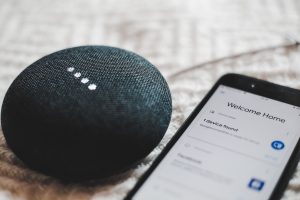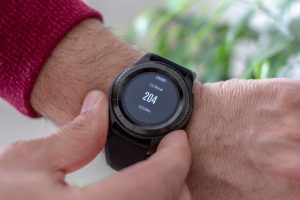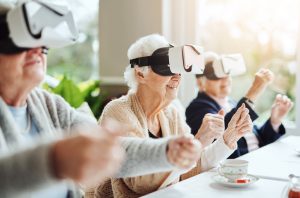How Technology Is Helping Us Stay Connected In The Home
5 technologies that make staying at home simple and safe
“The advance of technology is based on making it fit in so that you don’t really even notice it, so it’s part of everyday life.” – Bill Gates
Imagine a world without phones and computers. It’s hard to comprehend for most of us. Just two generations ago home care might have meant an increased risk of social isolation. Yet today’s technologies, smart phones, computers and a myriad of applications, are making a huge difference in the lives of those needing a little extra support to stay at home, from providing access to virtual sights, tours and experiences to the ability to stay in touch with health professionals and access health records without leaving home.
In a recent report by The Australian Institute of Health and Welfare it was noted that 88 percent of Australians aged 18 to 75 had access to a smartphone while 86 percent have access to the internet in the home. There is no doubt we are increasingly utilising technology to improve their lives, experience greater autonomy and independence, and stay at home longer, if not forever.
Advancements in technology move fast and it’s hard to know what’s going to help and what’s simply not worth worrying about. So as we head towards the future, we’ve put together a list of the 5 top technologies that are making home care a possibility for every Australian.
Voice Assisted Technology
Hey Siri… Google, Alexa, Cortana, it is not uncommon to hear people speaking to a device to make a phone call, turn off a light or on a television, set an alarm for an appointment or ask about the weather in order to plan ahead.
The future of voice assisted technology is far more exciting as the big tech companies compete to offer a more personalised and secure experience with responses individualised to suit the person asking. The technology is also being refined to better understand each user. Google Home already supports up to six different users and detects each voice, replying to questions with information specific to the person speaking. Ask Google what’s on for the day and it will recognise your voice, connect to your calendar and let you know what appointments you have. Or play your favourite music. Or select a podcast specifically for you. And rest assured, the main players in the industry are also focused on security, and ensuring that user information remains private and secure.
But while asking a machine to tell you what’s on for the day is fun, the real advantage is for those with limited dexterity or sight who may struggle to operate keyboards or see and select the commands on screens. Two common issues faced by older Australians: arthritis and sight deterioration, will be a thing of the past as voice-assisted technology increases.

Arthritis can make it extremely difficult for someone to pick up a phone, let alone pinch, slide or otherwise operate the screen of a smartphone with a series of hand-driven command. Typing on a keyboard can also be prohibitive when dexterity is compromised. Likewise those with poor or limited eyesight may have difficulty seeing the screen and therefore have difficulty operating technology that is largely reliant on sight.
As voice-assisted technology becomes the norm, everyday tasks such as operating appliances, locking doors, performing online tasks such as banking and shopping, even driving a car, as well as staying easily in touch with loved ones, is as simple as a voice command.
Smart Home
Smart homes are built to remembers things for you, such as turning your heating and air conditioning on and off to maintain the correct temperature, switching on lights as you leave or arrive home, watering gardens, turning off stoves… Not on command, but without being asked.
Now imagine a home that senses if a loved one has a fall, or forgets their medication. One that can remotely monitor blood pressure, heart rates or sugar levels and is networked to doctors, allied health professionals and of course family, to alert them if something seems wrong. A home that, quite literally, ‘senses’ your safety and wellbeing.
Like voice-assisted technology, the future of the smart home looks bright as companies work towards increasing the capabilities of the artificial intelligence (AI) powering the smart home. Confused? Basically, AI is the ‘stuff’ that tells machines how to respond to our requests, the artificial brain if you like. Tech companies are working hard to create AI that enables the machines and hardware in homes (think appliances and automated gadgets) to not just respond to our commands but to learn and predict individual behaviour and needs, to provide greater and more personalised assistance.
Combined with advances in voice-assisted technology, smart home technology is being perfected to ensure greater comfort and safety for anyone in the home which offers great peace of mind for those worrying about a parent who may be prone to falls, require regular medication or has perhaps become forgetful or careless. Now imagine knowing that, between caregiver and family visits, the smart home is wired for safety and practicality and loved ones. Smart homes are definitely worth considering when planning care in the home.
Telehealth
Feels like more confusing terminology? The simplest way to explain telehealth is the provision of healthcare services using video conference technology. Still not sure? It’s teleconferencing with your doctor from the comfort of your own home.
One for the future, and still in its infancy in Australia, US families are opting to have a loved one see a doctor via video rather than waiting a week or so to see a doctor in person. In Australia, GP’s have been restricted by Medicare requirements however specialists are able to offer video consulting and research has already shown that telehealth can increase the care and support of chronic disease management. The good news is the move is underway for GPs to offer telehealth services as we write this blog.
On the other hand, telemonitoring, an extension of telehealth, is now common practise in Australia, allowing a person to wear or carry an electronic device that can be monitored by their healthcare team regardless of where they are. This can allow for far more opportunities for the person. These devices most often connected to apps and software that both patient and doctor can manage and monitor, to know when the patient may need to seek assistance, make changes to treatment plans or pain management, or to monitor general wellbeing, all whilst capturing data that can be shared with their caregiver and healthcare team.

The implications of telehealth for in home care are far reaching. Although still having some way to go, a recent trial a rural GP undertook video consults for aged care patients and halved the number of required hospital visits. With a registered nurse, caregiver or family member with the patient, the GP or specialist can examine the patient, they can guide any examination necessary and see what’s going on in real time. For those with mobility issues telehealth alleviates the need to leave the house, but even if able to get out and about, telehealth speeds up the time in which a doctor can be seen as well as having positive implications for ongoing care after diagnosis, management of medicines and post operative care of patients.
Telehealth provides opportunities for caregivers, doctors and health providers to collaborate easily on the solutions for better healthcare outcomes for any patient and is definitely a technological advancement we expect to see grow in the near future.
Apps and Wearables
Speaking of digital health, we can’t overlook the advent of numerous apps and wearable gadgets that help relieve or at least support the increasing pressure on health service providers to manage and monitor an ever increasing ageing population.
Encouraging physical fitness and monitoring health problems such as high blood pressure, obesity and diabetes, health and fitness apps and wearables are proving to not only monitor but assist in changing behaviour in older people who become more conscious of their physical activity, taking up regular exercise, joining walking groups and getting involved in community activities and adopting a healthier active lifestyle.
In a study in Ireland it was also found that the use of apps and wearables alleviated social isolation as people became more active and sought to join communities to share their interest and help others become more aware of their own fitness. In one example a mother began using a device to monitor her activity and, seeing the results, her two daughters purchased devices and the three set up targets and began to compare results. At the time of the study the father was also planning to join in and the family reported feeling better connected. The daughters also noted a sense of peace being able to monitor their mother’s activity through a shared ‘dashboard’ offered by the app.

Fitbits, Apple watches, biometric tracking tights and water bottles that track your water intake, there are so many apps and wearables on the market that it’s best to do a bit of research based on your individual needs and speak to a health professional or sports specialist to figure out what will best support your loved one in their own home. But as a starting point, check out this article for the latest fitness gadgets in 2020.
Digital Education
Considering around 2.7 million Australians over the age of 50 confess to not understanding how to access the internet, yet more than half of Australia’s ageing population expressed a desire to know more, we can’t write an article on technology in the home without reminding you to help older parents and family members access a digital education and feel comfortable with the technology available to them.
Digital education for older Australians is more readily available than ever before, with free community programs designed to cover not just the basics but the tips and tricks that make life easier. From setting up smart phone to learning about the latest apps and how to load them, or understanding voice-assisted devices to connecting appliances to a smart home hub, digital education is an important part of empowering older people to make the most of the technology available to them.
If you’re not sure where to start, ’Be Connected’ is a program launched by Australian Government and The Office of the eSafety Commissioner and is designed to offer free courses on everything from how to access the internet to using devices and keeping in touch with others online. Created to ensure all Australians can “thrive in a digital world” Be Connected offers online learning resources as well as a network of community partners who offer in-person support.
As a bonus, getting a digital education will also help keep the mind active and provide opportunities for social interaction and the chance to learn new skills, revisit old hobbies, reconnect with long lost friends and stay in touch with family and friends now living or travelling interstate or overseas. The opportunities and benefits for are endless.

With the right planning and research you will find there is a digital solution to cover most lifestyle and wellness needs and ensure your loved ones can experience safer and happier care in their own home.
Nurse Next Door Care Team are happy to help with all your digital needs to help keep you connected at home. Learn more about our Home Care Services here!
